A WINNING IMPERATIVE.
 Monday, June 20, 2016 at 11:16AM
Monday, June 20, 2016 at 11:16AM Editor's Note: The following also appears as Peter's "Rants" column this week. -WG
By Peter M. De Lorenzo
Detroit. When the No. 68 Chip Ganassi Racing Ford GT crossed the finish line - which had been driven by Joey Hand, Dirk Muller and Sebastian Bourdais - winning the 24 Hours of Le Mans in the GTE PRO class this past Sunday, it was the culmination of years of intense work that had consumed the key players at the Ford Motor Company.
For Ford, the proud, family-owned company, which remains the only American manufacturer to win the most prestigious endurance race in the world overall for four straight years (1966 -1969), the decision to go back to Le Mans for the 50th Anniversary of Ford’s momentous first win was not taken lightly. On the contrary, it was the result of much hand-wringing and soul-searching by the top executives in the company.
The notion of going back to Le Mans started percolating within Ford eight years ago. Some executives welcomed the thought, while others weren’t so sure.
Ford CEO Mark Fields, in particular, was initially skeptical of the idea. For one very big reason: the commitment of resources – both financial and human - involved in order to not only be competitive, but to win, was daunting. (Fields keeps a scale wind-tunnel model of the ill-fated Jaguar-branded Formula 1 car in his office under a Lucite case as a reminder of the huge amounts of money the company expended on the program and how that kind of rampant spending “will never happen again” as he’s told me several times.)
For Fields, the idea of going back to Le Mans and challenging Porsche, Audi and Toyota for the overall victory was a non-starter, especially when the numbers it would take were bandied about. As in $500 million to design, engineer and develop a prototype over the first 30 months. And even that eye-opening expenditure would only get a Ford prototype to the grid at Le Mans; it certainly wouldn’t guarantee competitiveness, or a win. After that, the program would require spending at least $125 million annually before and until a Ford LMP1 car could challenge for the overall victory.
Daunting numbers indeed, and remember, these aren’t the halcyon days of the first go-around, when Henry Ford II decreed that Ford would go to Le Mans and beat Ferrari, dismissing the costs involved with his famous comment, “Whatever it takes.” No, this is the ROI era in motorsports, and Mark Fields wasn’t about to put those kinds of numbers on the table at a Ford board meeting.
But there were reasons to seriously consider going back to Le Mans for a class win in GTE PRO, and in those early days the biggest of those was that the new-generation Mustang was going to be made available globally for the first time in its history. So an intense study was undertaken to see what it would take to make the new Mustang competitive in the Le Mans GTE PRO class, under the code name “Project Silver.”
Ford’s product development chief, Raj Nair, identified and assembled the most talented engineers, designers, vehicle dynamic experts and aerodynamic specialists within the company and put them on the project. And outside racing partners, including Multimatic – the longtime Canadian company that had done engineering work and prepared racing Mustangs for Ford - were brought in to help evaluate the program.
This was a significant effort within the company, with many of the people involved adding the project to their normal workloads. But in the end, in order to make the Mustang competitive, it was determined that a wildly expensive “homologation special” would have to be created, and though it would have been by far the most radical and compelling Mustang ever built – complete with carbon fiber passenger cell – the project ground to a halt at the very last “go/no go” meeting in Mark Fields’ office. The bottom line? It was too expensive and some of the Ford regional executives weren’t keen on the financial contributions that would be required of them.
Had the idea of going back to Le Mans reached a dead end in the company’s modern era? Yes, but as it turns out, only momentarily.
Just a few months later, the idea of going back to Le Mans was resurrected, this time within context of an exceedingly intriguing product program that was put on the table: A next-generation Ford GT. Not another “wake up the echoes” nostalgia exercise like the most recent Ford GT had been, but a “statement” supercar that would project Ford’s technical expertise around the world; a supercar that would represent the tip of the technological spear for the entire company.
The idea of a next-generation Ford GT galvanized the company. As it turned out, the “best and brightest” at Ford, who were fortuitously identified through the Project Silver exercise, were now let loose on the project in earnest. And the “buy-in” from the top executives was swift and emphatic, with the marching orders from Mark Fields being crystal clear: “We aren’t going back to lose.”
I am not going to recount all of the details about the project here, but the very best thing about it was the fact that only a limited few individuals within the company knew of its existence, and the development of the new Ford GT was done in complete secrecy, which in this day and age is an achievement unto itself. And when the new Ford GT made its debut at the Detroit Auto Show in January 2015, it was a stunning reveal made all the more impactful by the fact that it was designed, engineered and developed without anyone knowing about it ahead of time.
Yesterday was a big day for the Ford Motor Company, as well it should be. And some of the True Believers in Dearborn need to be mentioned for their contributions. Chairman Bill Ford, for wholeheartedly supporting the effort from the very beginning. Mark Fields, for powering the company's commitment and going all-in to make it happen. Raj Nair, for orchestrating the tremendously talented True Believers within Design, Engineering and Ford Product Development. Dave Pericak, the boss of Ford Performance, who focused everyone involved on the Big Picture. Edsel Ford, for understanding what going back to Le Mans really meant for the company and to his father’s legacy. And Henry Ford III, for making sure the image of Ford and the success of the program was always front and center.
There are countless others who were involved that I am leaving out, but they know who they are, and more important the people within Ford know who they are.
And I need to mention two people in particular who were there when the idea of Ford going back to Le Mans was just a thought balloon: Jim Farley and Jamie Allison. Jim, an enthusiast/racer through and through, and now head of Ford’s European operations, was crucial in keeping the idea alive against all odds. And Jamie, who was previously head of Ford Racing but has moved on to another assignment inside the company, was instrumental in marshaling resources both within and outside the company in those early days. The contributions of these two men were essential to the ultimate success of the program.
And finally, the racers who were given the task to make the new Ford GT a winner: Larry Holt and his talented team at Multimatic, who not only helped develop the Ford GT into a winning racing machine but are responsible for building the street version as well. Multimatic’s contributions to the program cannot be overstated.
And last but not least, Chip Ganassi, who runs one of America’s most exceptionally talented racing organizations and who assembled a supremely talented group of drivers, technicians and crew personnel who helped deliver the momentous win for Ford at Le Mans, the very first time back.
The win for the Ford GT at the 24 Hours of Le Mans – 50 years after Ford’s overall win in 1966 – is a momentous achievement for everyone who has been involved with the program from the very beginning. It’s an extraordinarily proud moment for the entire company too. It reminds everyone hard at work at Ford that the company is about dedication, perseverance, creativity and the will to win. In fact, none other than its founder, Henry Ford, forged the company’s reputation and illustrious history through racing and it remains a shining legacy that’s as vibrant and essential today.
It also means that sometimes you have to say, “What the ----” and just go for it, and be willing to put it all on the line in the world’s most competitive arena in order to demonstrate who you are and what you’re about.
Congratulations to all on an exceptional effort.
And that’s the High-Octane Truth for this week.
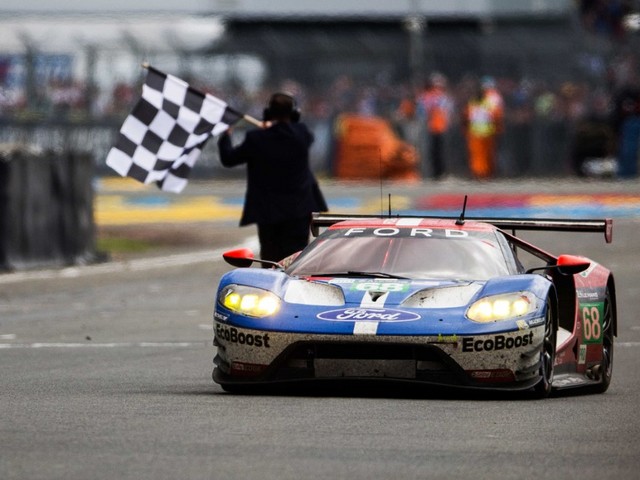
(Ford Images)
The No. 68 Ford GT of Sébastien Bourdais (FRA), Joey Hand (US) and Dirk Müller (GER) crosses the finish line at the 24 Hours of Le Mans on Sunday, winning the GTE PRO class.
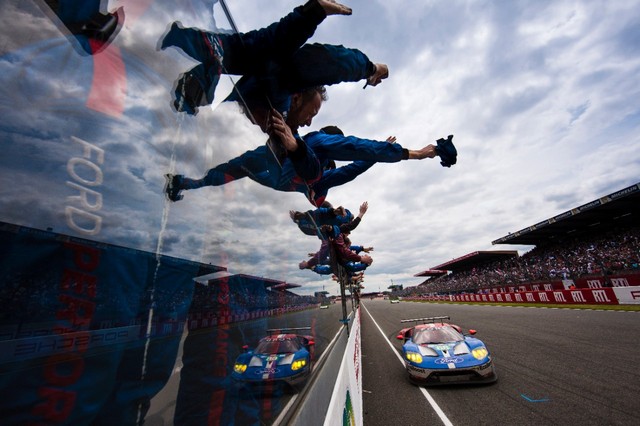
(Drew Gibson/Ford)
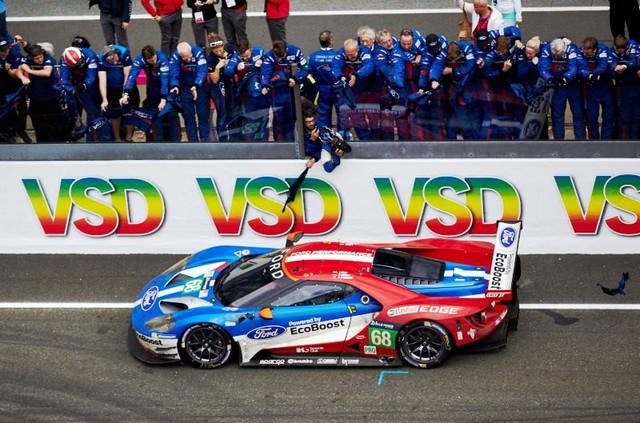
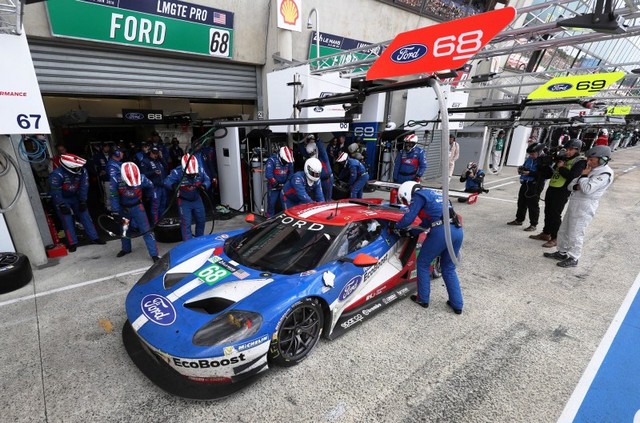
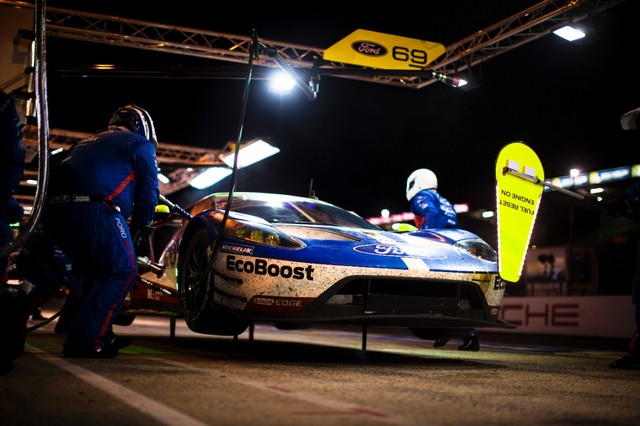
(Drew Gibson/Ford)
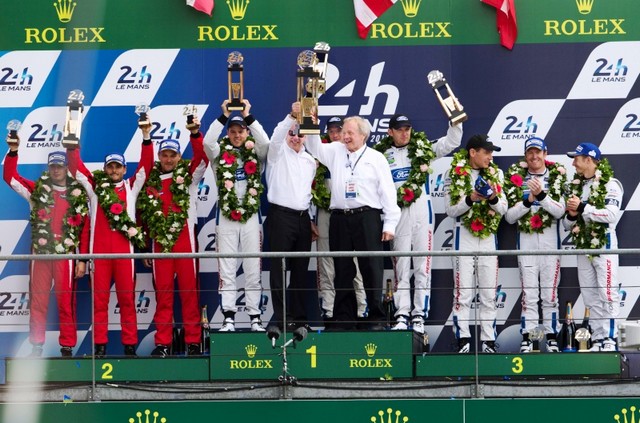
Editor’s Note: The following links are to the five-part video series about Ford’s Return to Le Mans, as well as an inspirational video by the company about the significance of the return to Le Mans, and a video of the victory at Le Mans. -WG
Publisher's Note: As part of our continuing series celebrating the "Glory Days" of racing, we're proud to present another noteworthy image from the Ford Racing Archives. - PMD

(Courtesy of the Ford Racing Archives)
Le Mans, France, June 12, 1967. A triumphant Dan Gurney and A.J. Foyt celebrate their overall victory in the 24 Hours of Le Mans that year in their No. 1 Shelby American Ford Mk IV. The European press dismissed the driving duo as being unable to go the distance at Le Mans, but Gurney laid out a brilliant plan for the race that they both followed to the letter and they dominated, winning by four laps. Ludovico Scarfiotti/Mike Parkes (No. 21 Spa Ferrari SEFAC Ferrari 330 P4) finished second and Willy Mairesse/"Jean Beurlys" (No. 24 Equipe Nationale Belge Ferrari 330 P4) finished third. It remains one of the greatest days in American racing. Watch a video here.
Publisher's Note: Like these Ford racing photos? Check out www.fordimages.com. Be forewarned, however, because you won't be able to go there and not order something. - PMD




